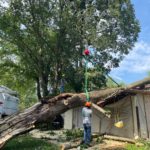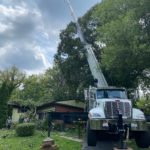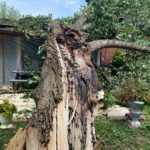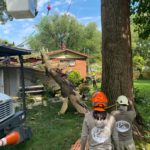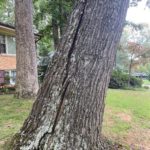Emergency Tree Service
Storms are common in the Northern Virginia region. Since we are tucked between the mountains and not too far from the ocean, this provides for ideal conditions for occasional storms such as micro bursts, thunderstorms, and even hurricanes. High winds, lightning, and wet saturated grounds can cause a tree to uproot and potentially fall onto a house or structure. It happens more often than one would like to think! Being in the business, we see first hand what storms and large trees in close proximity to your house can do. Don’t be too alarmed though, as it’s nice to have large trees on your property for a variety of reasons. Like keeping your home cooler in the heat of the summer by providing shade. An arborist can assess if a tree is in danger of potential storm damage or pose a risk to falling onto your home. Any tree can fall, even the healthiest, in a big storm. So if you have large trees on your property and are in close to your home, having your trees assessed annually by one of our ISA Certified Arborists is a good idea, and best of all it’s free! There are some things you can do to avoid these potential tragedies from happening, like tree pruning. A common thing that we tell our customers is, if you have large trees, sleep downstairs during known big storm events. Today, our weather forecasting is phenomenal. So take advantage of that by planning and being proactive, since you never know with a big enough storm, and large enough tree. A trained arborist eye can provide valuable information on whether a tree is safe or not. It’s nice to live in a forest-like setting, it really has its advantages.
So, what can you look for as a resident with large trees on your property?
- Large leaning trees. If a tree is within close proximity to your home, and is leaning towards your house, this is a no brainer. It should be looked at by an arborist. If you see any mounding around the base of the trunk (behind the trunk or lean) this is the first sign. If there is any cracking in the earth in that same area, this is also a sign to remove that tree right away.
- Dieback in the canopy. If a tree has any tip dieback in the tops of the branches, then that is a sign of root issue and tree decline. Most tree issues are underground in the root system, where you cannot see, but this is a sign of issues down under. There are specific things to look for to determine if there are apparent root issues.
- Bark issues. If the trunk or large limbs have any cracking, especially flaking like a spongy feel to it, that is a major concern. The bark should be hard in texture and healthy looking. Lichen and moss are very common and are on most trees in our area, so don’t worry about that! If fungus appears on the bark, that is another sign of issues. If frass (insect poop), it looks like sawdust, appears at the base of the trunk, the tree will likely need to be cut down as this is a tall tail sign that the tree is either dead or will be dead soon, and compromised.
- Large trees within close proximity of house. Even healthy trees can be damaged and fall over in a big enough storm. tree pruning can really help with this. Trees protect each other and are stronger together. if there is a solo tree that is in a common wind tunnel area, then it can be potential trouble. Or if a tree is on a hill, or low wet area, these are common things to look for when determining if a tree is Ok.
Summing it up
Generally speaking, its usually fine to have large trees by your house. Listed above are some of the potential things to keep an eye out for. Oak trees are the most common to uproot, but it can definitely happen to any tree species. Unfortunately, the Oaks in our area have been most recently affected by Oak wilt, due to drought. Maples, Poplars, Hickory, Cherry, and other species don’t appear to be quit as affected as the Oaks. Most Oaks are ok, and it is truly remarkable just how resilient and hardy, especially large trees, are.
JL Tree Service provides emergency tree removal service in Northern VA. We own our own cranes, have our own crane operators who work with tree crews daily. Having the necessary equipment, and experience are key factors in performing emergency tree service.
